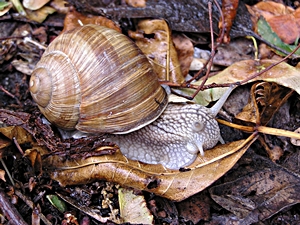
Roman snail (Helix pomatia). [RN]
By no means all mollusc species known from the Central European fauna have evolved there naturally. The role of so-called non-indigenous species, some of them introduced by man, is always a topic of discussion among scientists. On one hand their impact on ecology may be of importance, non-indigenous species often have no natural enemies and so can grow in numbers, often at the expense of indigenous species, on the other hand those species, even molluscs, may have a distinct severe influence not only on ecology, but even on economy.
Generally, non-indigenous species introduced after the discovery of America in 1492, are referred to as archaeozoa, species introduced later as neozoa. Basically neozoa, meaning newly introduced animal species, are set apart from neophyta, meaning plants. Even neomycota, newly introduced species of fungi, may be added, all together then referred to as neobiota, newly introduced life forms. For Germany, the federal office of natural preservation states 83 neozoa species among molluscs, of which 40 are established, meaning they have a constant place in the domestic fauna.
 Roman snail (Helix pomatia). [RN] |
A classical example for an archaeozoon is the Roman snail (Helix pomatia) in large parts of its current area of distribution. In Central Europe the Roman snail most probably moved in or was introduced after the last Ice Age, when man had begun to clear the large forests in order to make agricultural fields. Later the snail species was distributed largely by the Romans in great parts of their empire. Ancient deposits of kitchen waste witness of this snail's popularity in Roman cuisine, so its distribution area spread, as did the Roman empire. On the British Isles, Helix pomatia was proven to have been introduced in Roman times, which is why it today still is called the Roman snail.
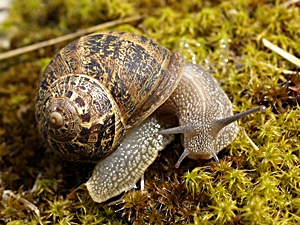 Brown garden snail (Cornu aspersum) from Catalonia. Picture: Ferrean Turmo Gort (Source). |
A relative of the Roman snail, the brown garden snail (Cornu aspersum), has probably been introduced to the British Isles earlier, in Celtic times.
In many other parts of the world, the brown garden snail is a neozoon. With the increasing globalisation of food transports, it was distributed nearly into the whole world. There is no continent today, with the exception of Antarctica, where the brown garden snail is not present. One of the reasons may also be the role of the brown garden snail as the only economically important snail species. In France, almost exclusive this species is cultivated as "escargot petit gris", and Napoleon's troops were not the only ones to effect its introduction in other parts of the world.
That way, the almost ubiquitous brown garden snail so has become really a "common snail", its second vernacular name in English. At least in Europe, the brown garden snail cannot be regarded as a garden pest, nor can the Roman snail. But this is the case in North America for example, where the snails can have a devastating impact on the monocultures of plantations and consequently are subject to prosecution.
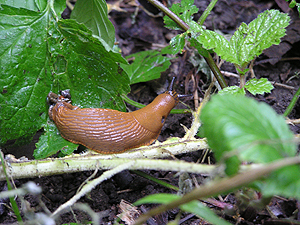 Spanish slug (Arion vulgaris). [RN] |
Probably the best known (or most notorious) agricultural pest from the group of mollusc neozoa in Europe is the Spanish or Lusitanian slug, Arion vulgaris, usually better known under its obsolete name of Arion lusitanicus. During the 20th century, this slug species has spread with breath-taking speed in almost all of Europe, replacing the indigenous slug species, such as the red slug (Arion rufus) and the black slug (Arion ater). The Spanish slug reproduces at a much greater rate (one egg batch may consist of as many as 400 eggs), but it also simply eats other slugs and snails (a knowledge only acquired in recent time). Possibly it even interbreeds with indigenous slug species, leading to bastardisation and so "breeding away" the indigenous slug species.
The Spanish slug's example shows quite well the possible impact of a neozoon's arrival on the system of agriculture, which is, no matter how stable the economy of the Western states may be, quite vulnerable to changes in ecology. It is assumed today that, when it appeared for the first time in Austria in 1972, the Spanish slug had been introduced with food transports from the Iberian peninsula.
On the other side, a large part of the slug species in the north-western United States and in nearby Canada have been introduced from Europe.
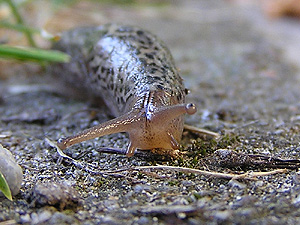 Leopard slug (Limax maximus). [RN] |
Agriculture and gardens moving away from nature to a growing degree, both have also been deprived of their natural allies: Toads, snakes, blindworms and hedgehogs, which in nature would keeps slugs in check, have all but disappeared. The application of snail poisons as the last measure also indiscriminately kills useful gastropod species. But according to recent research it is the indigenous slug species, which might be valuable against the Spanish slug. Among those there is the great grey slug or leopard slug (Limax maximus), which as a commensal species already is present in gardens as well as in cellars. Also, there is the worm slug, Boettgerilla pallens, also introduced from the East of Europe. Snail poison, however, makes no difference between harmful and useful species.
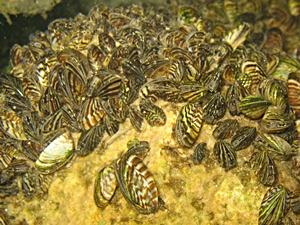 Zebra mussel colony on the lake floor (Dreissena polymor- pha). Picture: © Alexander Mrkvicka, Vienna (mrkvicka.at). |
Another harmful species with a high speed of distribution, this time coming from the East, is a bivalve species. The zebra or wandering mussel (Dreissena polymorpha), other than indigenous fresh water bivalves, is able to produce byssus thread, like a blue mussel does. When by the end of the 18th and during the 19th century, very many canals were built in Europe, the species was able to spread from the Black Sea region throughout Europe, where it distributed further along the rivers, clinging to ships with its byssus threads. Especially the so called bilge water, assembling in the hulk of ships and periodically pumped off, proves to be a quite efficient distribution vector for introduced species, which are released in foreign waters. Zebra mussels settle almost everywhere, on rocks, river walls, even on other mussels, which they afterwards may suffocate with the sediments of their indigestive deposits. Those mussels pose the largest problems for human economy, when they clog water pipes and effecting the obstruction of industrial plants near the water.
Only a few non-indigenous species harm the domestic ecological diversity in this way and therefore are called invasive species. Usually this happens especially, when the indigenous fauna is already weakened (today especially because of the environmental impairment and the destruction of habitats). The effects of invasive species are especially harmful, where they impact on unprotected island ecosystems, as has shown the example of the rosy wolf snail (Euglandina rosea) on the Pacific islands of Hawaii, the Marianas and Polynesia.
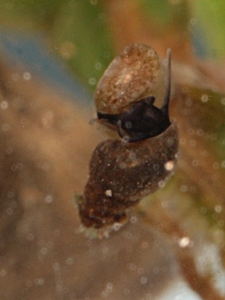 Potamopyrgus antipodarum. Picture: © Alexander Mrkvicka, Vienna. |
One neozoon, profiting in a special way of the indigenous fauna weakened by the changing ecological conditions, is the New Zealand mud snail (Potamopyrgus antipodarum). This small fresh water snail is related to the indigenous spring snails. Other than those, however, it is not threatened, but instead spreading in many places. Potamopyrgus antipodarum was introduced to England with ships at the end of the 19th century. From there it invaded many European rivers and lakes. On one hand, the species reproduces asexually to a high degree - for some time it had even been assumed it does exclusively so. Of course, this is biologically quite impossible and in the meantime, has been proven wrong, as some few male specimens of the species have been found. Besides, the New Zealand mud snail also spreads, where the effect of over-fertilisation make life impossible for most more susceptible mollusc species. Potamopyrgus antipodarum in principle cannot be called a harmful species, but the species obviously is an indicator for decreasing water quality and by growing in numbers, it does noticeably change the ecological network.
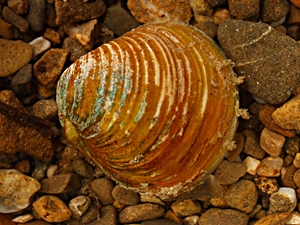 Chinese clam (Corbicula fluminea) from the Danube river. Picture: © Alexander Mrkvicka, Vienna (mrkvicka.at). |
Chinese clams (Corbicula fluminalis and Corbicula fluminea) are among the most recent neobiota. Only in the 80s, those bivalves originally from East Asia were first found in Europe. In America they are already in the 20s, probably introduced as food by Chinese living there. The Chinese clams, also referred to as good luck clams, also are popular aquarium clams and might have found their way into nature from those tanks.
Chinese clams are on the way of becoming an invasive species. Where they live in small numbers, they usually do not do any harm to nature, but where they appear in large numbers (from the US, growth rates in the hundreds are known, the clam also reproducing asexually), there may well be negative effects on their environment. Chinese clams clog water pipes, like zebra mussels, and they also harm populations of indigenous bivalve species by growing over them. In American lakes their deposits have already led to an algae bloom, in that regard they may have the an effect comparable to over-fertilization.
Similar to the New Zealand mud snail, the Chinese clams' largest potential is their ecological adaptability. Originally also inhabiting brackish water, they still are quite tolerant towards salinity, living in water with a salt content of up to 0.013%. Also the temperature range, in which they can thrive, is quite wide: between 2 and 30 °C. But their largest potential ought to be their ability to increase in numbers, leaving far behind most indigenous bivalve species.
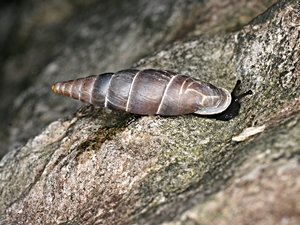 Bosnian door snail (Herilla bosniensis). Picture: © Alexander Mrkvicka, Vienna. |
Apart from the previously mentioned neozoa living in large numbers in wide areas, there is also a noticeable number of neozoa in Europe living in isolated places. So for example the region around Vienna is home to a number of neozoa, found nowhere else in Austria or elsewhere in Central Europe. The brown garden snail (Cornu aspersum), as already mentioned, of course does live in other parts of Europe. But Cornu aspersum is an oceanic species, which usually lives near the coast, where the climate is temperate and balanced, with warm summers and mild winters. Their habitat near Vienna usually would be much too far east and decidedly too continental. Regardless, the brown garden snail has managed to survive the Viennese winters for years. Another neozoon from the Vienna area is the Turkish snail (Helix lucorum). The area near Vienna constitutes the only place in Austria or Germany, where this species can be found. A bit further to the west, in the Klausen gorge near Mödling in Lower Austria, there is another neozoon, this time a door snail species, the Bosnian door snail (Herilla bosniensis). The Bosnian door snail, too, does occur nowhere else outside of its original distribution area in former Yugoslavia. In Simmering, a south-eastern quarter of Vienna, there is also the only place in Austria, where the girdled snail (Hygromia cinctella) can be found. Originally from the Northern Mediterranean, this snail lives here on sunny and dry meadows, in bushes, field groves and on railroad embankments.
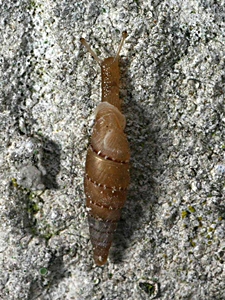 Italian door snail (Papillifera papillaris). Picture: Mauro Grano (Source). |
In a similar fashion, on Burgberg mountain near Donaustauf, not far away from Regensburg in Bavaria, several Austrian snail species are present, found nowhere else in Germany. But it is known, how these species, among them the Viennese banded snail (Cepaea vindobonensis), got there - in the 19th century, a local priest had brought several snails from Austria and put them to nature there. A similar case is the recent discovery of the Italian door snail Papillifera papillaris on the land of Cliveden House in Berkshire, England. This door snail species really had been introduced from Italy, with a transport of stone works intended for the main house. In crevices of the stones the door snails had managed to survive the journey well hidden.
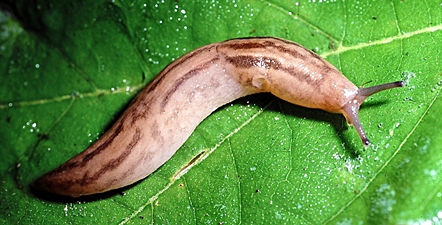 Three band garden slug (Lehmannia valentiana) from Victoria, Vancouver Island, British Columbia, Canada. Picture: Kristiina Ovaska, (Slugs and snails of British Columbia). |
Basically, it is rather hard for neozoa, especially those from warmer regions in the world, to settle on a sustained basis in nature in Central Europe. On one hand, it is quite improbable that the usually small number of snails in such a population is sufficient for the survival of the species. On the other hand, the first winter usually also is the last. This explains the presence of a number of so-called greenhouse species, like the American quick gloss snail (Zonitoides arboreus), originally distributed over large parts of Northern America as far south as Central America. In German, the snail is called a greenhouse dagger snail. and really the species usually only lives on imported plants in greenhouses and other especially warm places. In the meantime, several hints have been found that the species managed to settle in places outside of greenhouses. But on the other hand, Zonitoides arboreus is not a tropical snail species, and in America, it lives in many different climatic zones, as well.
There are also many slug species among greenhouse species, such as the three-band garden slug (Lehmannia valentiana), a relative of the indigenous tree slug (Lehmannia marginata). Originally from Southeast Europe, it is found today in Vienna, Lower and Upper Austria and in Salzburg. Besides, this slug species has also managed to settle in North America and in Australia.
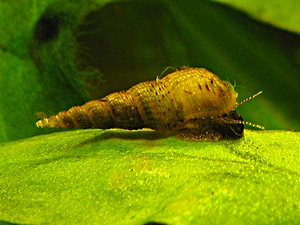 Red rimmed melania (Melanoides tuberculatus). Picture: Dennis L. (Source). |
Things are generally quite different for the many aquarium species set free in European waters. This explains why the red rimmed melania (Melanoides tuberculatus), a snail species usually kept in aquariums and originally from Southeast Asia, has been found in Austria (Schönbrunn, the Villach thermal baths in Carinthia and Bad Vöslau in Lower Austria) as well as in Germany. In the same fashion the American ram's horn snail (Planorbella duryi) most probably has been set free from the tanks of aquarium owners. Quite popular especially in its rose-coloured form (many ram's horn snails have haemoglobin and therefore red blood), this snail species today can be found in Baden near Vienna, in the Villach thermal baths and in Dornbirn in Vorarlberg. Similar conditions apply to the apple snail Pomacea bridgesi.
On the other hand, certainly not aquarium snails are the very special other snail species found in thermal springs and streams near Bad Vöslau and Bad Fischau in Lower Austria. Snails like the thermal spring pitch snail (Esperiana daudebartii acicularis), the thermal spring nerite (Theodoxus prevostianus) and the thermal spring snail (Bythinella pareyssii), instead are relics from warm interglacial periods, surviving in those arm spring since those ancient times.
Basically the chances of survival are decidedly better for tropical freshwater snail species, than of terrestrial snails. Most rivers today are noticeably warming anyway because of their economic role (e.g. where warm waste water from industrial plants is fed into them). While the conditions change for the worse for indigenous fresh water species, the chances for tropical fresh water species might improve considerably that way.
The nature preservation laws usually prohibit the putting to nature of non-indigenous species. Leaving aside the legal part, snail owners should think about the survival chances of tropical snails in Central European nature, for example eggs and juveniles of the extremely reproductive giant African land snails (Achatinidae), which would hardly survive their first winter in the wild. Should they manage to do so, imagine the impact of a sufficiently large population of snails, each 25 cm big, on the domestic fauna, as well as gardens and agriculture.
The reduced survival chances could improve, of course, with the increasing effects of global warming. Increasingly mild winters today already have consequences for the survival chances of harmful slug species, such as the Spanish slug (Arion vulgaris), which would usually die off during autumn. The growing climatic change could make it possible to more exotic gastropod species to settle in Central Europe.